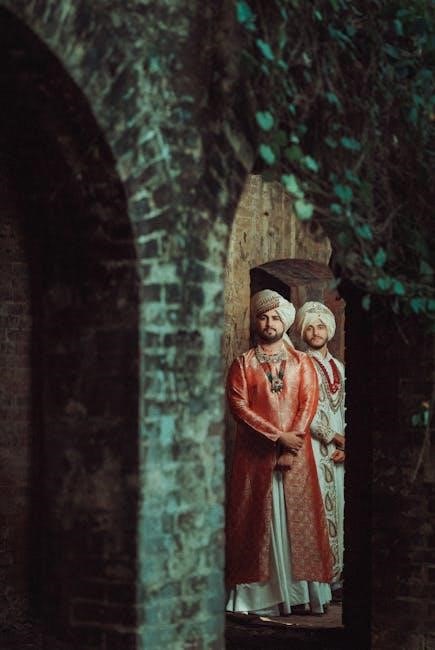
Ardas and Dohra are integral parts of Sikh prayers‚ reflecting communal devotion and spiritual connection. Ardas‚ a humble prayer‚ honors Sikh history and seeks divine blessings‚ while Dohra‚ a poetic couplet‚ emphasizes unity and faith.
Dohra‚ often recited after Ardas‚ underscores the Sikh community’s commitment to Guru Granth Sahib and the Khalsa’s enduring spirit‚ serving as a harmonious blend of spirituality and cultural heritage.

Overview of Ardas in Sikhism
Ardas is a sacred Sikh prayer‚ recited during various occasions‚ including daily rituals‚ before meals‚ and in gurdwaras. It is a communal prayer that seeks divine blessings and prosperity for all humanity. The prayer reflects remembrance of Sikh martyrs‚ the five beloved ones‚ and other prominent figures in Sikh history‚ emphasizing their sacrifices and devotion. Ardas is also recited before significant events‚ such as exams or ceremonies‚ to invoke divine grace and guidance.
Its structure includes praising God‚ honoring Guru Nanak and subsequent Gurus‚ and concluding with a plea for spiritual enlightenment. Ardas fosters humility‚ compassion‚ and fearlessness‚ encouraging Sikhs to embody these virtues and connect with the divine. It is an essential part of Sikh worship‚ promoting unity and moral upliftment.
Significance of Dohra in Sikh Prayers
Dohra‚ a rhyming couplet‚ holds profound significance in Sikh prayers‚ particularly as it follows Ardas. It encapsulates the essence of Sikh faith‚ emphasizing devotion‚ unity‚ and the eternal reign of the Khalsa. Composed by Guru Gobind Singh‚ Dohra serves as a testament to the Guru’s wisdom and the community’s unwavering commitment to their principles. Its inclusion in daily prayers reinforces the teachings of the Guru Granth Sahib‚ guiding Sikhs toward spiritual enlightenment and moral integrity. The Dohra’s poetic structure makes it memorable‚ allowing it to resonate deeply within the Sikh consciousness‚ fostering a sense of shared identity and purpose.
By reciting Dohra‚ Sikhs reaffirm their faith‚ honor their heritage‚ and seek divine guidance‚ ensuring its continued relevance in modern Sikh practice and education.
Historical Background of Ardas
Ardas originated during Guru Hargobind Singh’s era‚ emerging as a collective prayer for protection and victory. It evolved over centuries‚ blending Sikh history and spirituality‚ becoming a cornerstone of Sikh worship after its formalization in the 18th century;
Evolution of Ardas in Sikh History
Ardas evolved significantly over time‚ beginning as spontaneous prayers by Sikh Gurus and followers during challenging periods. Initially‚ it was a heartfelt plea for divine intervention‚ often recited in times of distress or celebration. Over centuries‚ Ardas became formalized‚ incorporating historical events‚ such as the martyrdom of Guru Arjan Dev and Guru Tegh Bahadur‚ and victories like the release of Guru Hargobind Singh from Gwalior. By the 18th century‚ it was standardized into the structured prayer Sikhs recite today. The inclusion of Dohra‚ a rhyming couplet‚ added poetic and musical depth‚ making Ardas a blend of history‚ spirituality‚ and community bonding. This evolution reflects the dynamic nature of Sikh traditions‚ adapting to historical events while preserving core beliefs and values.
Role of Guru Gobind Singh in Shaping Ardas
Guru Gobind Singh played a pivotal role in formalizing Ardas‚ infusing it with historical and spiritual significance. He introduced the concept of the Panj Piyare (Five Beloved Ones) to lead the prayer‚ making it a collective and solemn ritual. Guru Gobind Singh incorporated key elements into Ardas‚ such as remembrance of the Ten Gurus‚ the martyrdom of Guru Arjan Dev and Guru Tegh Bahadur‚ and the victory of Guru Hargobind Singh’s release from Gwalior. He also emphasized the importance of concluding Ardas with the Dohra‚ a poetic couplet that reinforces faith and unity. His contributions transformed Ardas into a standardized prayer‚ reflecting Sikh history‚ theology‚ and communal identity. This formalization under Guru Gobind Singh solidified Ardas as an indispensable part of Sikh ceremonies and daily worship.
Structure of Ardas
Ardas follows a structured format‚ beginning with remembrance of Gurus‚ historical events‚ and seeking divine grace. It concludes with the Dohra‚ reinforcing faith and unity.

Key Components of Ardas
Ardas is a structured prayer comprising essential elements that reflect Sikh spirituality and history. It begins with the invocation of Waheguru‚ followed by remembrance of the Ten Gurus‚ significant historical events‚ and martyrs who sacrificed for the faith. The prayer includes heartfelt supplications for guidance‚ strength‚ and well-being‚ often seeking divine grace for the community. It also encompasses reflections on the Five Beloved Ones (Panj Pyare) and the Khalsa panth. Each segment is recited with devotion‚ ensuring a connection to Sikh heritage and spiritual values. The Ardas concludes with the Dohra‚ a poetic couplet that reinforces faith and unity‚ encapsulating the essence of Sikh ideology.
Position of Dohra in the Ardas
Dohra holds a significant position in the Ardas‚ typically recited after the main prayer. It serves as a poetic conclusion‚ encapsulating the essence of the prayer and reinforcing Sikh values. The Dohra is a rhyming couplet that emphasizes the divine grace of Waheguru and the importance of living a virtuous life. Its placement at the end of Ardas ensures that the congregation reflects on its profound message‚ fostering spiritual unity and strength. The Dohra is often included in Punjabi PDF guides‚ making it accessible for learners to understand and recite it accurately. This couplet bridges the gap between prayer and daily life‚ inspiring Sikhs to uphold their faith and cultural heritage with pride and devotion.

Significance of Dohra
Dohra holds profound significance as a poetic conclusion in Sikh prayers‚ encapsulating divine grace and moral values. Its recitation strengthens spiritual connection and cultural identity‚ inspiring devotion and unity.
Dohra as a Rhyming Couplet in Sikh Poetry
Dohra‚ a rhyming couplet‚ is a poetic gem in Sikh literature‚ expressing spiritual and moral truths. Originating from Persian poetry‚ it was adapted into Punjabi‚ blending cultural and divine themes. Each dohra consists of two lines with a harmonic rhythm and rhyme‚ making it melodious and memorable. In Sikh scriptures‚ dohras often appear in the writings of Guru Nanak and other revered poets‚ conveying profound teachings about life‚ devotion‚ and divine connection. The rhyming structure enhances its recitation‚ making it a popular form of expression in Sikh prayers and kirtans. Dohra’s poetic beauty lies in its ability to simplify complex spiritual concepts‚ ensuring accessibility for all. Its inclusion in Punjabi PDF guides highlights its enduring relevance‚ preserving both linguistic heritage and spiritual wisdom for future generations.
Spiritual and Cultural Importance of Dohra
Dohra holds profound spiritual and cultural significance in Sikhism‚ serving as a bridge between divine connection and communal identity. It encapsulates timeless moral and ethical teachings‚ inspiring followers to embrace a virtuous life. As part of Sikh liturgy‚ dohra is recited during prayers and ceremonies‚ fostering a sense of unity and shared spirituality. Culturally‚ it preserves the richness of the Punjabi language and heritage‚ acting as a medium to transmit values across generations. Its rhythmic and poetic nature makes it accessible and memorable‚ reinforcing its role in both personal devotion and collective worship. Available in Punjabi PDF guides‚ dohra continues to inspire and educate‚ ensuring its relevance in modern Sikh practice and cultural preservation.

Dohra After Ardas
Dohra is traditionally recited after Ardas‚ concluding the prayer with a heartfelt supplication. Its recitation strengthens spiritual connection and seeks divine blessings‚ reflecting Sikh devotion and unity. Available in Punjabi PDF guides‚ it provides accessible learning and reflection for the community‚ enriching both individual and collective worship experiences.
Text and Meaning of the Dohra
The Dohra‚ a meaningful rhyming couplet‚ is a significant part of Sikh prayers‚ often recited after Ardas. Its text‚ rooted in Sikh scripture‚ seeks divine blessings and guidance. The Dohra emphasizes trust in the Almighty and the pursuit of a righteous path. Available in Punjabi PDF guides‚ its translation and interpretation help followers understand its spiritual depth. The verse serves as a reminder of the importance of faith and moral living‚ resonating deeply within the Sikh community. These resources provide accessible learning‚ ensuring the Dohra’s message endures‚ fostering devotion and reflection in daily life.
Recitation and Interpretation of the Dohra
The Dohra is traditionally recited after Ardas‚ with devotees standing respectfully to imbibe its spiritual essence. Its rhythmic and melodious recitation enhances the emotional connection to the divine. Interpretation of the Dohra reveals its profound teachings‚ emphasizing trust in God and the pursuit of righteousness. Available in Punjabi PDF guides‚ the Dohra’s text and meanings are accessible for deeper understanding. These resources often include translations and explanations‚ making it easier for learners to grasp its significance. The Dohra’s recitation fosters a sense of unity and shared faith among Sikhs‚ while its interpretation strengthens individual spiritual growth and communal harmony.

Role of Dohra in Sikh Identity
Dohra plays a vital role in shaping Sikh identity by strengthening cultural and spiritual bonds‚ reflecting shared values and traditions‚ and fostering unity among the community.
Dohra and Its Impact on Sikh Beliefs
Dohra significantly influences Sikh beliefs by reinforcing core values such as equality‚ justice‚ and devotion. It serves as a moral and spiritual guide‚ inspiring Sikhs to adhere to their faith’s teachings. The rhyming couplets encapsulate Guru Granth Sahib’s wisdom‚ making complex spiritual concepts accessible; Dohra’s recitation after Ardas strengthens the community’s connection to their heritage‚ fostering a sense of unity and shared identity. It also acts as a reminder of Sikh history and the struggles of the Gurus‚ inspiring resilience and faith in adherents. By integrating Dohra into daily prayers‚ Sikhs reaffirm their commitment to their beliefs‚ ensuring the preservation of their cultural and spiritual legacy for future generations.
Dohra as a Symbol of Sikh Unity
Dohra serves as a powerful symbol of Sikh unity‚ transcending individual identities to foster a collective sense of belonging. Recited collectively after Ardas‚ it unites Sikhs worldwide in shared spiritual experiences‚ reinforcing community bonds. The rhyming couplets often emphasize values like equality and justice‚ principles central to Sikhism. By reciting Dohra together‚ Sikhs reaffirm their commitment to these shared ideals‚ strengthening their collective identity. The availability of Punjabi PDF guides ensures that Dohra remains accessible to all‚ preserving cultural and linguistic heritage. This shared practice not only unites Sikhs in their faith but also underscores their shared history and values‚ acting as a beacon of unity within the global Sikh community.

Practical Usage of Dohra
Dohra is integral to Sikh daily prayers‚ recited after Ardas to reinforce faith and community bonds. Punjabi PDF guides provide accessible resources for learning and practicing Dohra rituals.
Dohra in Daily Prayers and Rituals
Dohra holds a vital place in Sikh daily prayers‚ recited after the Ardas to reinforce spiritual connection and community unity. It serves as a memorable rhyming couplet‚ making it easy to recite and reflect upon. Many Sikhs incorporate Dohra into their morning and evening rituals‚ using Punjabi PDF guides to learn its text‚ meaning‚ and proper pronunciation. These resources are particularly helpful for individuals and families seeking to deepen their understanding and practice. Additionally‚ Dohra is often taught in Sikh educational settings‚ ensuring its cultural and spiritual significance is passed down to younger generations. Its recitation fosters a sense of identity and shared faith‚ making it an indispensable part of Sikh daily life and communal worship.
Teaching Dohra to the Younger Generation
Teaching Dohra to the younger generation is essential for preserving Sikh cultural and spiritual heritage. Parents and educators use Punjabi PDF guides to simplify learning‚ focusing on pronunciation and meaning. Interactive methods‚ such as storytelling and music‚ make Dohra engaging for children. Many families incorporate Dohra recitation into daily routines‚ such as before meals or bedtime‚ to foster a sense of connection to Sikh traditions. Schools and gurudwaras also play a significant role by including Dohra in their curriculum and activities. By teaching Dohra‚ young Sikhs develop a deeper understanding of their faith and identity‚ ensuring its continuation for future generations.

Cultural and Historical Context
Dohra reflects Sikh history‚ culture‚ and spirituality‚ rooted in Punjabi heritage. Its inclusion in Ardas highlights its significance‚ preserved through generations via traditional practices and resources like Punjabi PDF guides.
Connection of Dohra to Sikh History

Dohra is deeply intertwined with Sikh history‚ serving as a poetic reflection of the community’s spiritual journey and cultural heritage; Originating in the Punjabi tradition‚ Dohra emerged as a concise yet profound form of expression‚ often used to convey divine truths and moral lessons. Its inclusion in Sikh prayers‚ particularly after Ardas‚ underscores its historical significance as a unifying element in Sikh rituals. Dohra’s composition and recitation have been influenced by key events and figures in Sikh history‚ such as the teachings of Guru Nanak and the bravery of Guru Gobind Singh. Over time‚ Dohra has evolved into a cherished part of Sikh identity‚ preserved through generations via texts like Punjabi PDF guides‚ ensuring its cultural and historical legacy endures.
Cultural Significance in Sikh Community
Dohra holds immense cultural significance in the Sikh community‚ serving as a bridge between spirituality and tradition. It is a vital part of Sikh heritage‚ reflecting the values of courage‚ devotion‚ and equality. Dohra’s rhythmic and poetic nature makes it accessible and memorable‚ allowing it to resonate deeply with followers of all ages. In Sikh gatherings‚ Dohra is often recited after Ardas‚ fostering a sense of unity and shared identity. Its inclusion in Punjabi PDF guides ensures that the younger generation can learn and appreciate this cultural treasure. Dohra not only preserves the Punjabi language but also keeps alive the stories and teachings of Sikh gurus‚ making it a cornerstone of Sikh cultural and spiritual life.
Resources for Learning Dohra

Punjabi PDF guides provide detailed scripts and meanings of dohra after ardas‚ making it accessible for learners. Online platforms offer tutorials and downloads for easy practice.
Punjabi PDF Guides for Dohra
Punjabi PDF guides for dohra after ardas are widely available online‚ offering detailed scripts‚ translations‚ and explanations. These guides are designed to help learners understand and recite dohra accurately. Many Sikh scriptural websites and gurdwara repositories provide these PDFs for free download. They often include transliterations for non-Punjabi speakers‚ making the content accessible to a global audience. Additionally‚ these guides frequently include historical context and spiritual significance‚ enhancing the learner’s understanding. They are ideal for both personal study and community education‚ ensuring the preservation of Sikh traditions. These resources are particularly useful for younger generations seeking to connect with their heritage through prayer and scripture.
Online Platforms for Dohra Learning
Several online platforms offer resources for learning dohra after ardas‚ making it accessible to global learners. Websites like SikhNet and SikhiToTheMax provide detailed guides‚ audio recitations‚ and translations. YouTube channels such as Basics of Sikhi and Sikh Mastery share video tutorials and explanations. These platforms often include downloadable Punjabi PDFs of dohra texts‚ along with transliterations and meanings. Additionally‚ apps like iSikhi and SikhPrayer offer interactive tools for practicing dohra and understanding its significance. These resources cater to both beginners and advanced learners‚ ensuring a comprehensive understanding of dohra in the context of Sikh prayers and culture. They also promote the preservation and dissemination of Sikh traditions worldwide.
Ardas and Dohra are cornerstone Sikh prayers‚ embodying spiritual and cultural essence. Their recitation fosters unity and faith. Easily accessible via Punjabi PDFs‚ they remain vital in Sikh practice.
The Dohra after Ardas holds profound significance in Sikh prayer‚ serving as a poetic conclusion that reinforces spiritual themes. Its inclusion in Punjabi PDF guides ensures accessibility for learners‚ preserving its cultural and religious importance. The Dohra’s rhythmic structure and meaningful lyrics make it a cherished part of Sikh heritage. By incorporating it into daily rituals and teachings‚ the Sikh community maintains a strong connection to its faith and history. These resources not only aid in understanding but also in passing down the tradition to future generations‚ ensuring its enduring relevance;
Final Thoughts on Dohra and Ardas
Dohra and Ardas are integral to Sikh spirituality‚ embodying the faith’s core values and history. The Dohra‚ as a poetic and rhythmic element‚ enhances the emotional depth of prayers‚ making them more meaningful. Punjabi PDF guides have simplified access to these sacred texts‚ ensuring their preservation and transmission to future generations; Ardas‚ with its structured format‚ unites Sikhs globally‚ fostering a sense of community and shared identity. The inclusion of Dohra after Ardas underscores its cultural and spiritual significance‚ serving as a reminder of Sikh heritage and divine connection. These elements remain vital in maintaining Sikh traditions and inspiring devotion. Their enduring relevance ensures they will continue to guide and uplift the Sikh community.